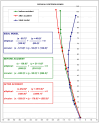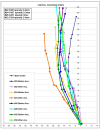Abnormal Static Sagittal Cervical Curvatures following Motor Vehicle Collisions: A Retrospective Case Series of 41 Patients before and after a Crash Exposure
- PMID: 38732372
- PMCID: PMC11082978
- DOI: 10.3390/diagnostics14090957
Abnormal Static Sagittal Cervical Curvatures following Motor Vehicle Collisions: A Retrospective Case Series of 41 Patients before and after a Crash Exposure
Abstract
Previous investigations have found a correlation between abnormal curvatures and a variety of patient complaints such as cervical pain and disability. However, no study has shown that loss of the cervical curve is a direct result of exposure to a motor vehicle collision (MVC). This investigation presents a retrospective consecutive case series of patients with both a pre-injury cervical lateral radiograph (CLR) and a post-injury CLR after exposure to an MVC. Computer analysis of digitized vertebral body corners on CLRs was performed to investigate the possible alterations in the geometric alignment of the sagittal cervical curve.
Methods: Three spine clinic records were reviewed over a 2-year period, looking for patients where both an initial lateral cervical X-ray and an examination were performed prior to the patient being exposed to a MVC; afterwards, an additional exam and radiographic analysis were obtained. A total of 41 patients met the inclusion criteria. Examination records of pain intensity on numerical pain rating scores (NPRS) and neck disability index (NDI), if available, were analyzed. The CLRs were digitized and modeled in the sagittal plane using curve fitting and the least squares error approach. Radiographic variables included total cervical curve (ARA C2-C7), Chamberlain's line to horizontal (skull flexion), horizontal translation of C2 relative to C7, segmental translations (retrolisthesis and anterolisthesis), and circular modelling radii.
Results: There were 15 males and 26 females with an age range of 8-65 years. Most participants were drivers (28) involved in rear-end impacts (30). The pre-injury NPRS was 2.7 while the post injury was 5.0; p < 0.001. The NDI was available on 24/41 (58.5%) patients and increased after the MVC from 15.7% to 32.8%, p < 0.001. An altered cervical curvature was identified following exposure to MVC, characterized by an increase in the mean radius of curvature (265.5 vs. 555.5, p < 0.001) and an approximate 8° reduction of lordosis from C2-C7; p < 0.001. The mid-cervical spine (C3-C5) showed the greatest curve reduction with an averaged localized mild kyphosis at these levels. Four participants (10%) developed segmental translations that were just below the threshold of instability, segmental translations < 3.5 mm.
Conclusions: The post-exposure MVC cervical curvature was characterized by an increase in radius of curvature, an approximate 8° reduction in C2-C7 lordosis, a mild kyphosis of the mid-cervical spine, and a slight increase in anterior translation of C2-C7 sagittal balance. The modelling result indicates that the post-MVC cervical sagittal alignment approximates a second-order buckling alignment, indicating a significant alteration in curve geometry. Future biomechanics experiments and clinical investigations are needed to confirm these findings.
Keywords: buckling; cervical lateral radiograph; cervical lordosis; motor vehicle collision; neck pain; trauma.
Conflict of interest statement
Authors E.A.K. and I.M.M. declare no competing interests. J.W.H. is a compensated researcher for CBP Non-Profit, Inc. P.A.O. is a compensated consultant for Chiropractic BioPhysics, NonProfit, Inc. J.R.F. is the CEO of PostureCo, Inc., and receives compensation for the sale of PostureRay® software; this software was not used in this investigation. D.E.H. is the CEO of Chiropractic BioPhysics® (CBP®) and provides post-graduate education to healthcare providers and physicians. Spine rehabilitation devices are distributed through his company; none of these devices were used in this manuscript. D.E.H. is the president of CBP Non-Profit, Inc., a not-for-profit spine research foundation.
Figures






Similar articles
-
Modeling of the sagittal cervical spine as a method to discriminate hypolordosis: results of elliptical and circular modeling in 72 asymptomatic subjects, 52 acute neck pain subjects, and 70 chronic neck pain subjects.Spine (Phila Pa 1976). 2004 Nov 15;29(22):2485-92. doi: 10.1097/01.brs.0000144449.90741.7c. Spine (Phila Pa 1976). 2004. PMID: 15543059
-
Positive Outcomes Following Cervical Acceleration-Deceleration (CAD) Injury Using Chiropractic BioPhysics® Methods: A Pre-Auto Injury and Post-Auto Injury Case Series.J Clin Med. 2023 Oct 9;12(19):6414. doi: 10.3390/jcm12196414. J Clin Med. 2023. PMID: 37835057 Free PMC article.
-
[CHANGE AND CLINICAL SIGNIFICANCE OF CERVICAL SPINE SAGITTAL ALIGNMENT OF ADOLESCENT IDIOPATHIC SCOLIOSIS].Zhongguo Xiu Fu Chong Jian Wai Ke Za Zhi. 2016 Mar;30(3):336-42. Zhongguo Xiu Fu Chong Jian Wai Ke Za Zhi. 2016. PMID: 27281880 Chinese.
-
The 3 Sagittal Morphotypes That Define the Normal Cervical Spine: A Systematic Review of the Literature and an Analysis of Asymptomatic Volunteers.J Bone Joint Surg Am. 2020 Oct 7;102(19):e109. doi: 10.2106/JBJS.19.01384. J Bone Joint Surg Am. 2020. PMID: 33027127
-
Pediatric cervical kyphosis in the MRI era (1984-2008) with long-term follow up: literature review.Childs Nerv Syst. 2022 Feb;38(2):361-377. doi: 10.1007/s00381-021-05409-z. Epub 2021 Nov 22. Childs Nerv Syst. 2022. PMID: 34806157 Review.
Cited by
-
Re-establishing the cervical lordosis after whiplash: a Chiropractic Biophysics® spinal corrective care methods pre-auto injury and post-auto injury case report with follow-up.J Phys Ther Sci. 2023 Mar;35(3):270-275. doi: 10.1589/jpts.35.270. Epub 2023 Mar 1. J Phys Ther Sci. 2023. PMID: 36866005 Free PMC article.
-
Documenting Cervical Spine Injuries Following Negative MRI Findings: Clinical and Medico-Legal Overview of Dynamic Imaging.Cureus. 2025 Jul 16;17(7):e88121. doi: 10.7759/cureus.88121. eCollection 2025 Jul. Cureus. 2025. PMID: 40687407 Free PMC article. Review.
-
Improvement in Chronic Low Back and Intermittent Chronic Neck Pain, Disability, and Improved Spine Parameters Using Chiropractic BioPhysics® Rehabilitation After 5 Years of Failed Chiropractic Manipulation: A Case Report and 1-Year Follow-Up.Healthcare (Basel). 2025 Apr 3;13(7):814. doi: 10.3390/healthcare13070814. Healthcare (Basel). 2025. PMID: 40218115 Free PMC article.
References
Grants and funding
LinkOut - more resources
Full Text Sources
Miscellaneous

